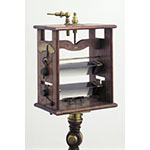Two equilateral glass prisms are hinged horizontally in a wooden frame by means of brass ring nuts. The upper prism can be raised or lowered by turning a screw that makes it slide in the frame. A pointer shows the upper prism's inclination on a graduated brass scale (40° - 0° - 40°). The frame also carries two jointed brass arms, which probably supported other accessories. The frame itself is fitted to an elbow-joint for positioning the apparatus on an optical bench. The two combined prisms produced two light spectra simultaneously, which could be superposed to create color blends. Isaac Newton used a combination of several prisms for his famous experiments on the separation of white light into a polychromatic spectrum.
Related people
Typology
Context
In depth










